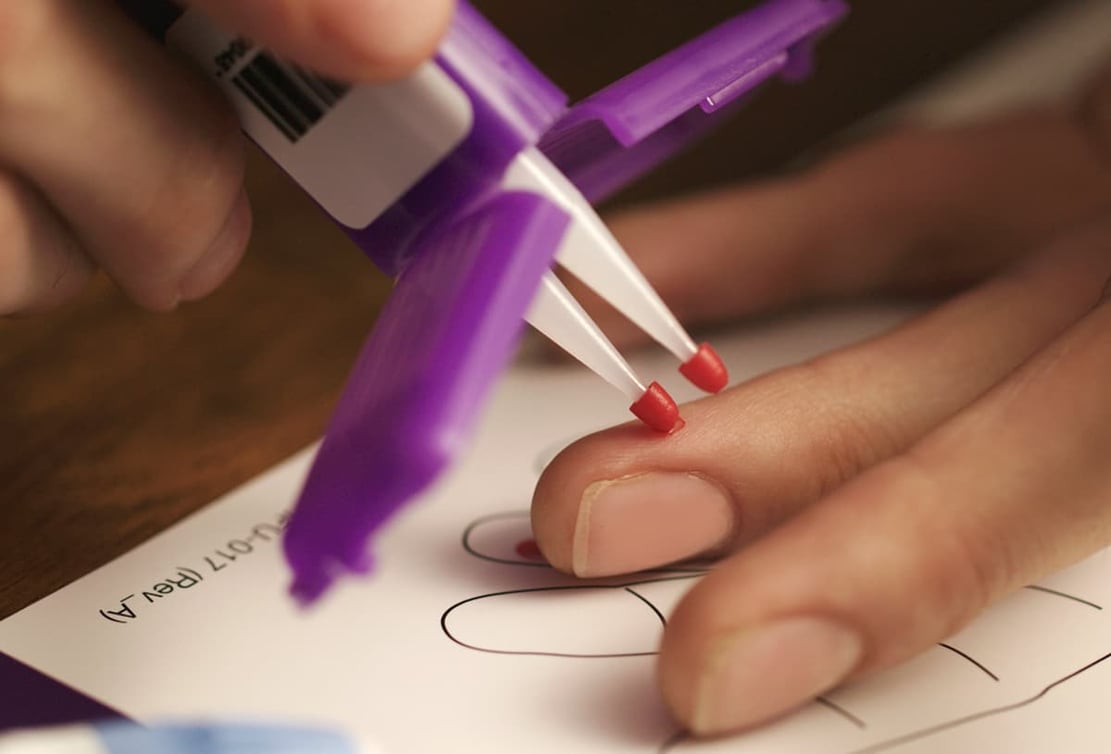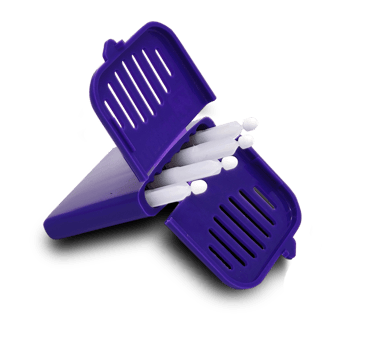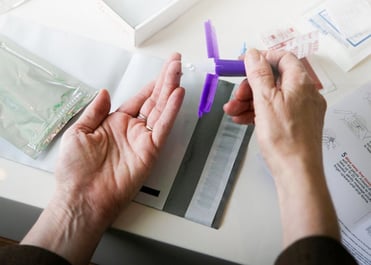Share this
how to collect a blood sample at home with VAMS technology
by Neoteryx Microsampling on Mar 11, 2019 3:12:00 AM
 The rise of VAMS® microsampling technology has dramatically simplified the process of specimen collection, whether for collecting blood or another bio-fluid.
The rise of VAMS® microsampling technology has dramatically simplified the process of specimen collection, whether for collecting blood or another bio-fluid.
For blood collection, it is no longer necessary to undergo painful venipuncture, to involve phlebotomists and complex lab equipment, or to use dry ice and biohazard shipping to get the blood sample safely from the clinic to the lab for analysis.
Now, instead of getting poked in the arm with a big needle, there is minimally invasive finger-prick / finger-stick sampling to gather a tiny sample – a "microsample" – for research, clinical trials, patient monitoring, and more.
 A blood sampling advance known as volumetric absorptive microsampling, led to the development of Mitra® devices with VAMS® technology at Neoteryx, the microsampling product brand of Trajan Scientific and Medical.
A blood sampling advance known as volumetric absorptive microsampling, led to the development of Mitra® devices with VAMS® technology at Neoteryx, the microsampling product brand of Trajan Scientific and Medical.
VAMS combines the best of DBS, or dried blood spot cards, and other dried blood collection methods, but VAMS overcomes or solves for their limitations (such as hematocrit bias, among many others).
Many researchers and clinical trial managers are embracing the Mitra device with VAMS technology for its utility in remote microsampling studies. The rise of microsampling is explained by several factors. It's convenient and easy to use, even for untrained participants self-collecting samples at home. It's economical, it saves money for lab directors and study managers.
 Almost anyone (with minimal training via video and illustrated instructions) can collect a small, precise sample of blood (or another biological fluid), anywhere, at any time. It can be done on mountain treks, in low-resourced regions, or in a person’s own living room.
Almost anyone (with minimal training via video and illustrated instructions) can collect a small, precise sample of blood (or another biological fluid), anywhere, at any time. It can be done on mountain treks, in low-resourced regions, or in a person’s own living room.
The remote microsampling process is so smart and simple, nearly anyone can do it correctly with ease:
- The Finger-prick: A quick poke from a lancet to a fingertip can draw a drop or two of blood. That’s all that’s needed for collecting a high-quality specimen sample.
- The First Sample: Hold the white sponge tip of the device steady over the blood drop for the moment it takes to fully absorb the 10-20 microliters of blood (or other biological fluid).
- The Second Sample: Repeat this same process to fill as many device tips as needed, whether you’re using the Mitra® Cartridge two-pack or four-pack. It’s quick and simple.
- Seal in Specimen Bag: Once all device tips are filled, enclose your samples in the included self-sealing specimen bag (including the packet of drying desiccant that is in the specimen bag). The sealed pouch fits inside the pre-addressed mailing envelope included in your kit.
- Ship: Drop the envelope in the nearest mailbox to send to the central lab for sample processing and analysis.
Why is this process so important? Microsampling, while absurdly simple, has numerous applications across science, drug research, health and wellness.
In Europe, important areas in which microsampling is having an impact is in remote therapeutic drug monitoring and remote patient monitoring.
Visit our Microsampling Library to read published articles from scientific and medical journals to learn how microsampling technology provides an important missing link in the patient monitoring ecosystem in England, France, and other European countries.
Learn how our microsampling devices and sample collection kits provide a secret weapon for those in pursuit of more patient-centric and value-based care.

Image Credits: Trajan, Neoteryx
Share this
- Microsampling (206)
- Research, Remote Research (119)
- Venipuncture Alternative (105)
- Clinical Trials, Clinical Research (83)
- Mitra® Device (73)
- Therapeutic Drug Monitoring, TDM (51)
- Dried Blood Spot, DBS (39)
- Biomonitoring, Health, Wellness (30)
- Infectious Disease, Vaccines, COVID-19 (24)
- Blood Microsampling, Serology (23)
- Omics, Multi-Omics (21)
- Decentralized Clinical Trial (DCT) (20)
- Specimen Collection (18)
- Toxicology, Doping, Drug/Alcohol Monitoring, PEth (17)
- Skin Microsampling, Microbiopsy (14)
- hemaPEN® Device (13)
- Preclinical Research, Animal Studies (12)
- Pharmaceuticals, Drug Development (9)
- Harpera Device (7)
- Industry News, Microsampling News (5)
- Antibodies, MAbs (3)
- Company Press Release, Product Press Release (3)
- Environmental Toxins, Exposures (1)
- July 2025 (1)
- May 2025 (1)
- April 2025 (2)
- December 2024 (2)
- November 2024 (1)
- October 2024 (3)
- September 2024 (1)
- June 2024 (1)
- May 2024 (1)
- April 2024 (4)
- March 2024 (1)
- February 2024 (2)
- January 2024 (4)
- December 2023 (3)
- November 2023 (3)
- October 2023 (3)
- September 2023 (3)
- July 2023 (3)
- June 2023 (2)
- April 2023 (2)
- March 2023 (2)
- February 2023 (2)
- January 2023 (3)
- December 2022 (2)
- November 2022 (3)
- October 2022 (4)
- September 2022 (3)
- August 2022 (5)
- July 2022 (2)
- June 2022 (2)
- May 2022 (4)
- April 2022 (3)
- March 2022 (3)
- February 2022 (4)
- January 2022 (5)
- December 2021 (3)
- November 2021 (5)
- October 2021 (3)
- September 2021 (3)
- August 2021 (4)
- July 2021 (4)
- June 2021 (4)
- May 2021 (4)
- April 2021 (3)
- March 2021 (5)
- February 2021 (4)
- January 2021 (4)
- December 2020 (3)
- November 2020 (5)
- October 2020 (4)
- September 2020 (3)
- August 2020 (3)
- July 2020 (6)
- June 2020 (4)
- May 2020 (4)
- April 2020 (3)
- March 2020 (6)
- February 2020 (3)
- January 2020 (4)
- December 2019 (5)
- November 2019 (4)
- October 2019 (2)
- September 2019 (4)
- August 2019 (4)
- July 2019 (3)
- June 2019 (7)
- May 2019 (6)
- April 2019 (5)
- March 2019 (6)
- February 2019 (5)
- January 2019 (8)
- December 2018 (3)
- November 2018 (4)
- October 2018 (7)
- September 2018 (6)
- August 2018 (5)
- July 2018 (8)
- June 2018 (6)
- May 2018 (5)
- April 2018 (6)
- March 2018 (4)
- February 2018 (6)
- January 2018 (4)
- December 2017 (2)
- November 2017 (3)
- October 2017 (2)
- September 2017 (4)
- August 2017 (2)
- July 2017 (4)
- June 2017 (5)
- May 2017 (6)
- April 2017 (6)
- March 2017 (5)
- February 2017 (4)
- January 2017 (1)
- July 2016 (3)
- May 2016 (1)
- April 2016 (2)


No Comments Yet
Let us know what you think